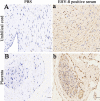Identification of equine herpesvirus 8 in donkey abortion: a case report
- PMID: 34991640
- PMCID: PMC8734136
- DOI: 10.1186/s12985-021-01738-2
Identification of equine herpesvirus 8 in donkey abortion: a case report
Abstract
Background: Equine herpesvirus-8 (EHV-8) is one of the most economically significant viruses that infect mammals of the genus Equus worldwide, which cause severe respiratory diseases and abortion in horses. However, there is no report of abortion caused by EHV-8 in donkeys.
Case presentation: The present case report is about a 4-year-old donkey having an abortion and showing a serious respiratory issue on the 296th day of pregnancy. Bacteriological and molecular tests were used to screen possible bacterial/viral pathogens to detect the etiological agent. Salmonella abortus equi, EHV-1, EHV-4, and EAV were all negative in the current study. EHV-8, on the other hand, was the only agent that was isolated and identified.
Conclusions: This was for the first time that EHV-8 had been isolated from a donkey in China. EHV-8 infection can cause abortion in donkeys; therefore, veterinarians and breeders should be aware of it.
Keywords: Abortion; Donkey; Equid herpesviruses 8; Virus isolation.
© 2022. The Author(s).
Conflict of interest statement
The authors declare that they have no competing interests.
Figures




Similar articles
-
Characteristics and epidemiological investigation of equid herpesvirus 8 in donkeys in Shandong, China.Arch Virol. 2023 Mar 4;168(3):99. doi: 10.1007/s00705-023-05704-x. Arch Virol. 2023. PMID: 36871102
-
First identification and isolation of equine herpesvirus type 1 in aborted fetal lung tissues of donkeys.Virol J. 2024 May 27;21(1):117. doi: 10.1186/s12985-024-02390-2. Virol J. 2024. PMID: 38802935 Free PMC article.
-
Abortion in donkeys associated with Salmonella abortus equi infection.Equine Vet J. 2019 Nov;51(6):756-759. doi: 10.1111/evj.13100. Epub 2019 Apr 10. Equine Vet J. 2019. PMID: 30868638
-
A review of equid herpesvirus 1 for the veterinary practitioner. Part A: clinical presentation, diagnosis and treatment.N Z Vet J. 2014 Jul;62(4):171-8. doi: 10.1080/00480169.2014.899945. N Z Vet J. 2014. PMID: 24597778 Review.
-
A review of equid herpesvirus 1 for the veterinary practitioner. Part B: pathogenesis and epidemiology.N Z Vet J. 2014 Jul;62(4):179-88. doi: 10.1080/00480169.2014.899946. N Z Vet J. 2014. PMID: 24597839 Review.
Cited by
-
Characteristics and epidemiological investigation of equid herpesvirus 8 in donkeys in Shandong, China.Arch Virol. 2023 Mar 4;168(3):99. doi: 10.1007/s00705-023-05704-x. Arch Virol. 2023. PMID: 36871102
-
Characterizing the Pathogenesis and Immune Response of Equine Herpesvirus 8 Infection in Lung of Mice.Animals (Basel). 2022 Sep 20;12(19):2495. doi: 10.3390/ani12192495. Animals (Basel). 2022. PMID: 36230234 Free PMC article.
-
Reproductive Disorders in Donkeys: Current Evidence and Update.Animals (Basel). 2024 Aug 28;14(17):2494. doi: 10.3390/ani14172494. Animals (Basel). 2024. PMID: 39272279 Free PMC article. Review.
-
Cobalt Protoporphyrin Blocks EqHV-8 Infection via IFN-α/β Production.Animals (Basel). 2023 Aug 22;13(17):2690. doi: 10.3390/ani13172690. Animals (Basel). 2023. PMID: 37684954 Free PMC article.
-
Heme oxygenase-1 is an equid alphaherpesvirus 8 replication restriction host protein and suppresses viral replication via the PKCβ/ERK1/ERK2 and NO/cGMP/PKG pathway.Microbiol Spectr. 2024 Apr 2;12(4):e0322023. doi: 10.1128/spectrum.03220-23. Epub 2024 Mar 5. Microbiol Spectr. 2024. PMID: 38441979 Free PMC article.
References
-
- Browning GF, Ficorilli N, Studdert MJ. Asinine herpesvirus genomes: comparison with those of the equine herpesviruses. Adv Virol. 1988;101(3–4):183–190. - PubMed
-
- Ficorilli N, Studdert MJ, Crabb BS. The nucleotide sequence of asinine herpesvirus 3 glycoprotein G indicates that the donkey virus is closely related to equine herpesvirus 1. Adv Virol. 1995;140(9):1653–1662. - PubMed
Publication types
MeSH terms
LinkOut - more resources
Full Text Sources

